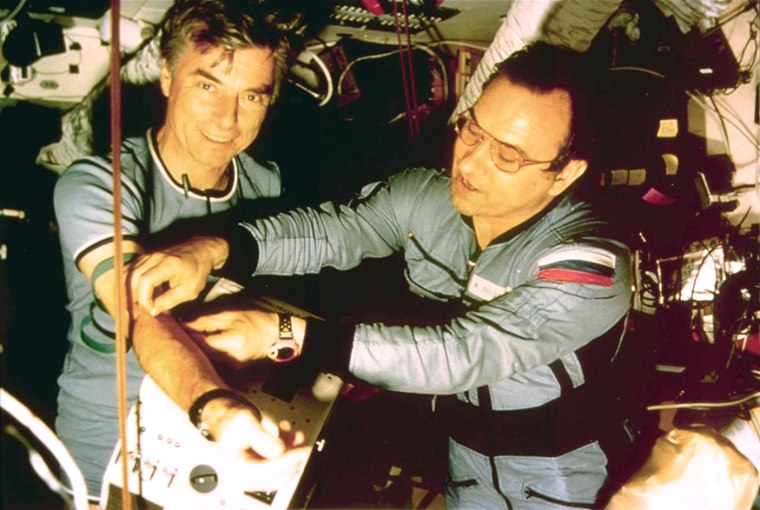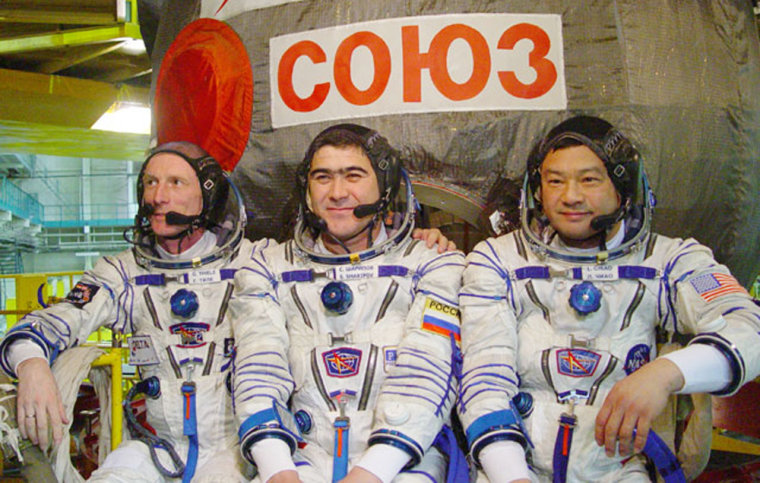NASA has decided not to accept Russia's suggestion for a yearlong space mission beginning later this year. Instead, crews will continue to make the standard six-month duty tour until space shuttle flights resume, presumably next year.
Space agency sources told MSNBC.com of the decision over the weekend, and the news was confirmed in an e-mail distributed Monday afternoon by NASA Headquarters in Washington.
With the launch of the next crew to the international space station, NASA and its international partners have embarked on the ninth expedition since permanent orbital occupancy began in November 2000. Since the loss of Columbia on Feb. 1, 2003, the space station crews have traveled exclusively on Russian space vehicles.
Six months from now, two more men — Kyrgyz-Russian cosmonaut Salizhan Sharipov and NASA astronaut Leroy Chiao — will be launched aboard another Soyuz. But whether or not these men would face the typical six-month sojourn, or one perhaps twice as long, has sparked tremendous controversy within NASA.
Last month, Russia proposed to NASA to keep the crew launched this October on the station through October 2005. That would give Russia leeway to sell two, or even three, of the seats on next April's scheduled Soyuz replacement mission to paying customers for a short space visit. Under the current arrangement, two of the seats would have to be taken up by the professional replacements for Sharipov and Chiao.
The Russians were willing to extend the mission. Sharipov told a recent press conference: “A year in space is of course a major undertaking, but we are ready for it.” He added that “for a cosmonaut, the longer the flight the better.” But NASA officials didn't share that view.
MSNBC.com was told that on April 6, Michael Kostelnik, the associate administrator for spaceflight at NASA Headquarters, wrote to Moscow saying that the U.S. side could not support the 12-month option. He cited medical concerns for the crew members as well as general scientific reasons.
After repeated inquiries on Monday, NASA Headquarters sent an e-mail notice to MSNBC.com as well as other news organizations, confirming the confidential accounts:
"Last week, NASA sent a response letter to our Russian partners that says we believe this isn't right time to extend International Space Station crew missions from six months to a year," the notice read. "We believe the timing is not appropriate, in part, because the station is currently in a reduced operational state. We don't have sufficient countermeasures in place yet to offset the effects that a longer duration space flight would have on the crew. Also, the impacts on planned station biomedical research still needs to be addressed."
"We know we'll eventually need to extend the amount of time astronauts are in space to prepare for the missions outlined in the new vision for space exploration. In fact, as International Space Station Program Manager Bill Gerstenmaier has said, we have people studying what it would take to implement longer expedition missions. However, we don't see a way to practically address these concerns in time to support the Expedition 10 mission this October."
Coincidentally, the current handover between the station's departing and arriving crews marks a 12-month space endurance milestone for NASA. On Wednesday evening, just hours after the new crew docks to the station, Expedition 8 commander Michael Foale will become the first American astronaut (and the 20th human being) to accumulate a full year of spaceflight experience. His earlier shuttle missions and a long stay on Mir in 1997 amounted to slightly less than six months in space, and his current stint on the space station accounts for the rest of the year.
Internal disagreement
In recent weeks, MSNBC.com has talked extensively with several of the key players in the internal NASA debate over the 12-month-straight mission plan. Their comments — made on condition of anonymity — reveal the depth of the disagreements within the space agency between those who wanted to seize the unexpected opportunity and those who counseled caution.
A former astronaut now working at NASA Headquarters in Washington expressed support for accepting the offer: “It’s all about exploration and human endurance,” he said. And he welcomed the challenge: “It’s a forcing function to get [the doctors] to realize we’re going to need to — no kidding — investigate longer-duration missions.”
“It’s not the engineers and operators this time,” he continued. “It’s the docs who get to get challenged. The ball has landed in their court, [and] the answer can’t simply be ‘no.’ …”
Still, he admitted a 12-month stay at the space station would pose difficulties, and if it weren't for the recent White House call to use space station missions to prepare for interplanetary missions, such a plan would not have been considered.
“Four months is an optimum [duration],” he said. “Six months is kind of a grind.” Longer than that made sense to him only in planning for missions beyond low Earth orbit.
A senior NASA astronaut in Houston, on the other hand, snorted in derision at the idea of spending a year in space. “It’s way too long,” he told MSNBC.com. When reminded that there were numerous Russian cosmonauts still walking around after spending that much time — or longer — in orbit, he shook his head and countered, “They’re not walking very well.”
Russians hold the record
The record for continuous time in space is currently 14½ months, set by Dr. Valery Polyakov on Mir in 1994-1995. Earlier, a pair of cosmonauts had made a 366-day flight in 1987-1988, and a cosmonaut in 1999 had his six-month voyage extended to 12½ months when his first "return ticket" was sold to a Slovakian guest cosmonaut.

Other men have made flights in the 10- to 11-month range. Medical issues remain uncertain, but none of the cosmonauts seems to have shown any long-term health damage — at least, not in any publicly available medical studies.
Still, other American astronauts voiced their objection. “The radiation dose would be too high,” said one, ”and the high noise levels for that long could lead to permanent hearing loss.” Reportedly, Chiao initially told NASA managers in Houston that he was unwilling to stay away from his family that long. During a preflight press conference, Expedition 9 astronaut Mike Fincke also voiced concerns about medical issues and being away from family that long.
'We're not ready yet'
A senior NASA science official in Houston shared his detailed reasoning about why such a mission duration was undesirable for now. “It’s a good thing to do down the road,” he admitted. “But we’re not ready yet.”
For the science of studying human space adaptation, he explained, NASA wanted more “data points” — more individuals to fly a standard four- to six-month mission. “That length is sufficient to characterize the response of test subjects to space,” he explained. All physiological effects, from bone loss to muscle loss and vestibular impacts, show up by this point.
“Twelve months doesn’t buy much, but it does take away one data point,” he explained. From this perspective, two people each spending six months in space would be twice as important as one person going for 12 months.
The key to long-duration interplanetary missions, he continued, was in developing countermeasures, and here again “it’s more valuable to have many test subjects.” Developing those countermeasures would require flying many astronauts for up to six months and using the station’s sophisticated diagnostic equipment to measure what happens to their bodies. Next, the countermeasures would have to be tested on six-month flights. Only then would it make medical sense to conduct a 12-month test, the science official insisted.
Prudence vs. boldness
“From a medical perspective,” another doctor confided, “NASA hasn’t answered the questions that need answering.” And he worried about rumors from Moscow: “This was about the length of time the Russians were beginning to think there were some irreversible physical changes.”
Another Houston official recently admitted, “we are all looking at the yearlong option,” and then added, “Personally, I think it will be a pretty good gut check on how seriously we really are about breaking out of low Earth orbit.”
For now, methodical prudence appears to have trumped inspirational boldness. But the Russian offer has for the first time made NASA think seriously about longer-duration flights and the unavoidable fact that they must be done in the years to come. That, too, is progress toward Mars.
